September, 2019

Who Wants Round Flowers?
Recently we acquired a copy of Louis M. Boyle's Out West: Growing Cymbidium Orchids and Other Flowers (1952, Los Angeles: Times-Mirror Press), the story of Boyle's amazing Cymbidium and "Old West" village on his retirement ranch, El Rinconada, near Ojai. Boyle died the next year, 1953, and the copyright was never renewed, so this colorful bit of orchid and Southern California nostalgia is now in the public domain. The volume, richly illustrated, is a reminiscence of his career in the sheet metal business, which was sold in 1939, after which he bought the rancho and caught a bad case of Cymbidium fever.
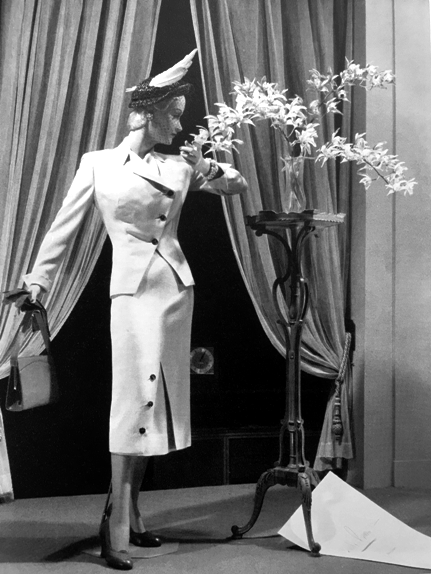
Department store window, circa 1950, showing the perfect outfit to wear to an orchid society meeting! We know from a couple newspaper clippings that at least one or two SCOS members dressed in style for society events, in outfits from Dinel's in Long Beach. The Cymbidium flowers are certainly not of the full, round type favored by judges, but rather the unimproved "bird-in-flight" type that emphasizes the slim lines of the ensemble.
Writing around 1950, Boyle could see around him a confluence of fashion and horticulture. Post-war fashion seized on the Cymbidium flower, and especially the arching spikes where each flower seemed to be caught in mid-flight, as the epitome of elegance. At the same time, orchid judging, following the lead of the Royal Horticultural Society, was emphasizing full, round flowers. This trend in Cymbidium breeding was, however, not so far along; it was still possible to give new Cymbidium hybrids names recalling birds, butterflies, and various sprites.
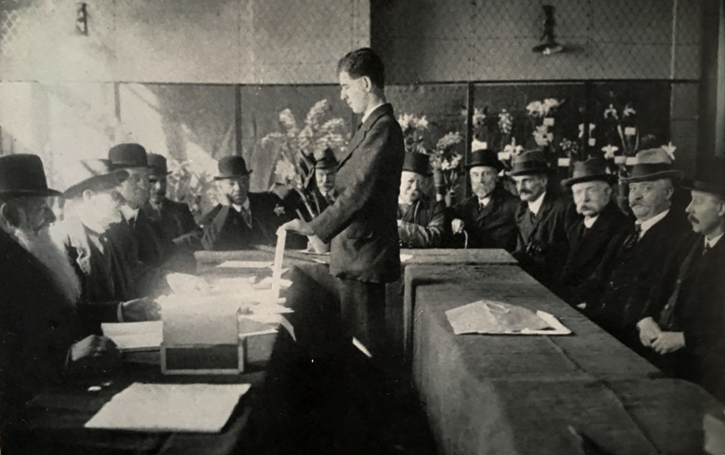
Orchid Committee of the Royal Horticultural Society in action, 1917. Do these men look like qualified judges of fashion and beauty?
However, we couldn't help but notice a sort of disconnect between the Cymbidium flowers favored by orchid growers, even then, versus those used by professional designers for interior fashion layouts and department store mannequins. The growers apparently wanted more flowers, standing high above the leaves, and fuller, rounder petals and sepals. Moreover, the flowers were often photographed in isolation, almost as if the plant itself was not particularly relevant. On the other hand, the fashion designers tended to use arching, flexible cut stems, on which the individual flowers were well separated, each hanging elegantly and not touching the others, and emphasizing the slim, almost fragile profile of the petals, resembling birds in flight. There seem to be two very different concepts of "beauty" in play here. This point can be appreciated by considering a few illustrations from Out West that we have included here.
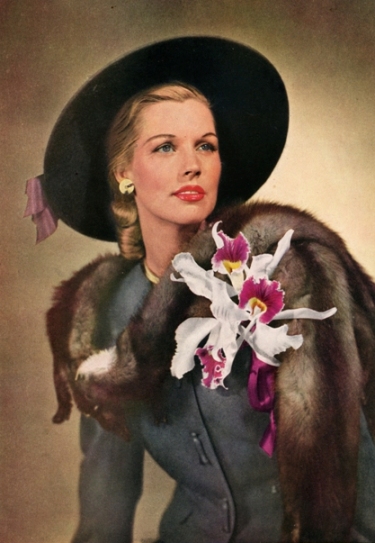
Photo courtesy of Art Chadwick
Fashion plate from the 1940's. Costume designer and AOS Judge Carol Beule gave us a "reading" of this illustration. "An 'afternoon' suit dressed up further with furs and orchids. It's an 'event' ensemble. Late afternoon cocktails and dinner out with dancing, in the fall or early winter most probably, by the colors depicted. NYC chic. Waldorf Astoria dinner and dancing."
From our viewpoint, the emphasis on round flowers seems to grow from looking very closely at individual flowers, in isolation from the rest of the plant. Viewed in this way, a round flower may be very pleasing, a sort of exercise in color and symmetry. The flower with "more" is "better". Over the Cymbidium generations (and likewise over the generations of Cattleyas, Odontoglossums—before RHS, in a fit of exasperation, did away with them—, Vandas, etc.), the plants whose individual flowers had "more" were consistently judged "better", and were used in the next generation to produce even rounder, larger flowers.
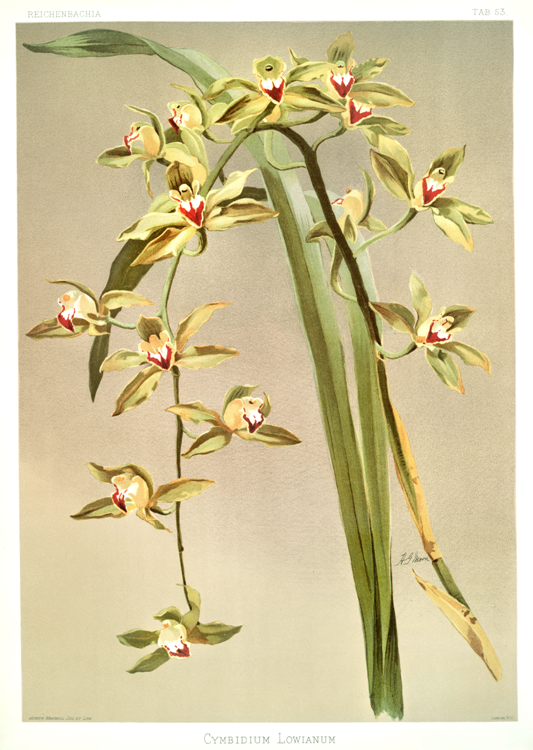
Cymbidium lowianum, figure from Reichenbachia, 1888. This is a fine example of botanical illustration, in which the subject has carefully been arranged to form a pleasing artistic composition within the boundaries of the page.
But in the 1950's, designers did not seem to be particularly interested in round flowers. Women's fashions and interior design emphasized line in preference to volume. This was the age of impossibly slim figures with perfectly tailored details that highlighted the graceful curves of the dancer, or the subtle lines of Oriental brush painting. Oriental influences abounded, in fact, as if American tastes were seeking a calmer, more peaceful esthetic (Zen) after the uproar of the war years. Unimproved Cymbidium flowers, such as Cym. eburneum and Cym. lowianum, provided exactly what the designers were looking for. Even bigger flowers sometimes appeared in corsages, such as Cattleya hybrids involving what was then Laelia purpurata, the long, arching segments again emphasizing line in preference to volume, as in the fashion plate that Art Chadwick has shared with us.
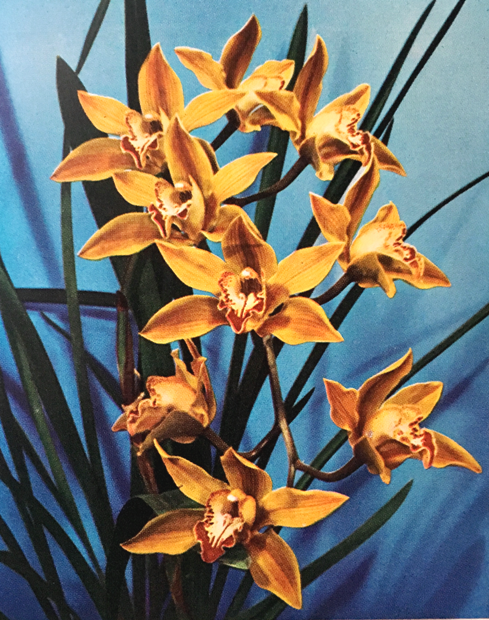
Cym. Rosette 'Sunrise' (Altair × Pearl, registered in 1940). Photograph from Boyle's Out West, notice the effect created by the shadows of the leaves against the backdrop.
A point to consider: Suppose we substituted big round flowers in all the old fashion plates. Would the effect be the same? We think not! The individual arching lines of the original flowers would be gone, we would see only a solid mass of indistinct flowers.
Not every aspect of "beauty" is easily quantifiable. Standards for orchid judging have historically relied on some sort of point system, based where possible on objective measurements. That history was predictable: if orchid judging were to produce consistent and repeatable results, was there ever any option but to rely on measurements? Perhaps the gentlemen of the RHS Orchid Committee should not be faulted for undertaking an impossible task, defining beauty. In any event, under a measurement-based system, it is hard to see how larger, fuller, rounder flowers would not have the advantage. However, if there are other kinds of beauty, and many of us believe there are, point systems and measurements would seem ill-equipped to assess them. Some of us, let us admit it, are not drawn exclusively to fat, round flowers! Those old-time bird-like Cymbidiums still catch our eye with their subtle elegance.
Ultimately, there are many ideas of beauty. It is hard to improve on nature, and, as products and examples of nature ourselves, it is inevitable that we will experience the many creations of nature, in all their diversity, as intrinsically beautiful. When it comes to orchids, point judging isn't all there is.
A Favorite Non-Awarded Flower from the Long Beach Judging Center
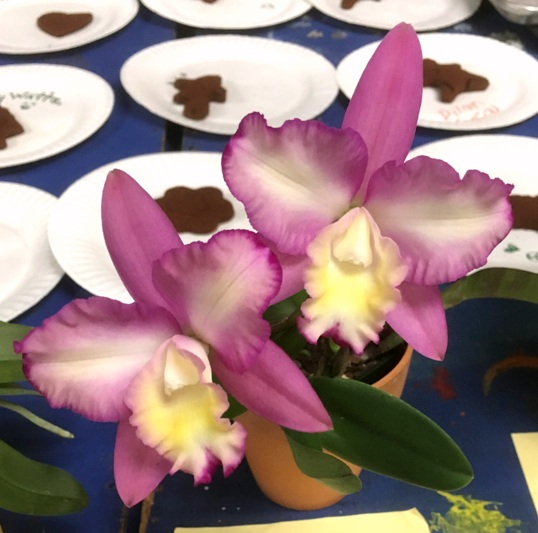
Photo by John McCoy
Rhyncatlaelia Ada Henriquez, exhibited by Sunset Valley Orchids at the December 17, 2018 judging session in Long Beach, CA
In December, 2018, we spotted a compact Cattleya seedling at the Long Beach Supplemental AOS Judging Center. What got our attention was the perfect "bisque" texture of the flowers, as if they were formed from unglazed porcelain. Not a speck of dust, no irregularities whatever. The plant did not win an award that night, but the cross, then labeled as Slc. Angel Eyes × Slc. Picotee Fire, has since been registered by Fred Clarke of Sunset Valley Orchids as Rhyncatlaelia Ada Henriquez. In case you haven't been following the wholesale revisions of the Cattleya alliance, Rhyncatlaelia is the official intergeneric name for Rhyncolaelia (used to be part of Brassavola) × Cattleya × Laelia. You'll need to know the official abbreviation, too: Ryc. The subtle pastel shading, the gently ruffled edges of the petals and lip, and the fine texture are a particularly elegant addition to the ensemble of "compact" Cattleyas for which Fred has become justly famous.
The amazing parade of extraordinary orchids that show up at the judging center is a huge draw for South Coast Orchid Society meetings. Be sure to take a peek in the back room at the next meeting. Visitors are always welcome in the judging center!
Best Orchid Flower We've Seen in an Long Time!
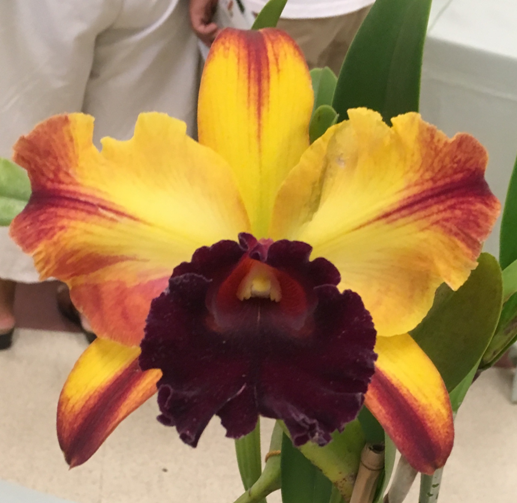
Photo by John McCoy
Rlc. Toshie Aoki 'Pizazz', grown by Bobby Ignacio, at the South Bay Orchid Society show, September 14, 2019
The annual show and sale staged by the South Bay Orchid Society at South Coast Botanic Garden isn't the biggest, but it is still one of the most interesting for the opportunity to talk to some vendors we don't see very often, and, especially, for the quality of the plants that are exhibited. We visited this year's show on September 14, 2019 and were stunned to see this plant, Rlc. Toshie Aoki 'Pizazz' AM/AOS, grown by long-time SBOS member Bobby Ignacio from Carson.
Toshie Aoki cultivars turn up at shows fairly often. They vary widely; some cultivars lack the red flaring completely, others have varying degrees of flaring. Flower size varies, too. We most often see flowers around 4 to 5 inches across. Toshie Aoki was created by the almost legendary Hawaiian orchid nurseryman Masatoshi Miyamoto. Mr. Miyamoto was famous for his dislike of paperwork and correspondence, and he never registered most of his crosses. However, at some point, Dr. A. G. Tharp, one of our past presidents, prevailed on Mr. Miyamoto to allow him, Tharp, to take care of the registration for several of Miyamoto's hybrids, including Toshie Aoki, so that they could be submitted for AOS judging and get the awards they deserved.
The first of the Toshie Aoki's to be awarded was one exhibited at our own Long Beach judging center by Dr. Tharp, a cultivar he called 'Miniflares', which achieved an AM/AOS, 81 points, on July 27, 1981, with flowers measured at almost 5 1/2" across. But the best of the cross has proved to be 'Pizazz', first exhibited by Howard Starke, well-known as an orchidist in Honolulu, at the Hawaiian Exposition, on July 1, 1983, with flowers measuring nearly 5 3/4" across, scoring 84 points and an AM/AOS. 'Pizazz' came back in 2017 for a second round, achieving 88 points when exhibited for AOS judging in Cincinnati by John Jaworski.
What distinguishes 'Pizazz' from the other cultivars of Toshie Aoki is the extent and subtle shading of the flares, and the exquisite form and presentation of the flowers. We understand 'Pizazz' has been cloned, but we don't know if it can be found for sale at this time.
We posted this quick photo on Facebook as soon as we got home from the show, and within a couple days, it had been "liked" or "shared" by over 2,000 people, by far a new record for our little SCOS Facebook page! That was a big surprise, because Facebook is already overflowing with pretty orchid pictures. We can only suppose that it was the combination of color and form that caused this unexpected reaction.
We had a chance to chat with Bobby about his Toshie Aoki. It came into his hands about ten years ago, as a party favor at the annual holiday party of South Bay Orchid Society! Bobby reports that the plant is a slow grower, but it has remained healthy. It has survived all the pesky slugs and bush snails that inhabit his outdoor growing area, under shade cloth—a familiar story for most of us in SCOS! This year, the plant developed two spikes, each with a single flower, but on opposite sides of the plant. The one facing the sun developed very nicely. The other, facing a wall, wasn't as strong. When we grow our orchids outdoors, we can control some things, such as the amount of light and water, but not others, such as the bugs and critters that wander through our gardens when we're not looking. We all lose a few flowers, but the occasional grand success keeps us going!